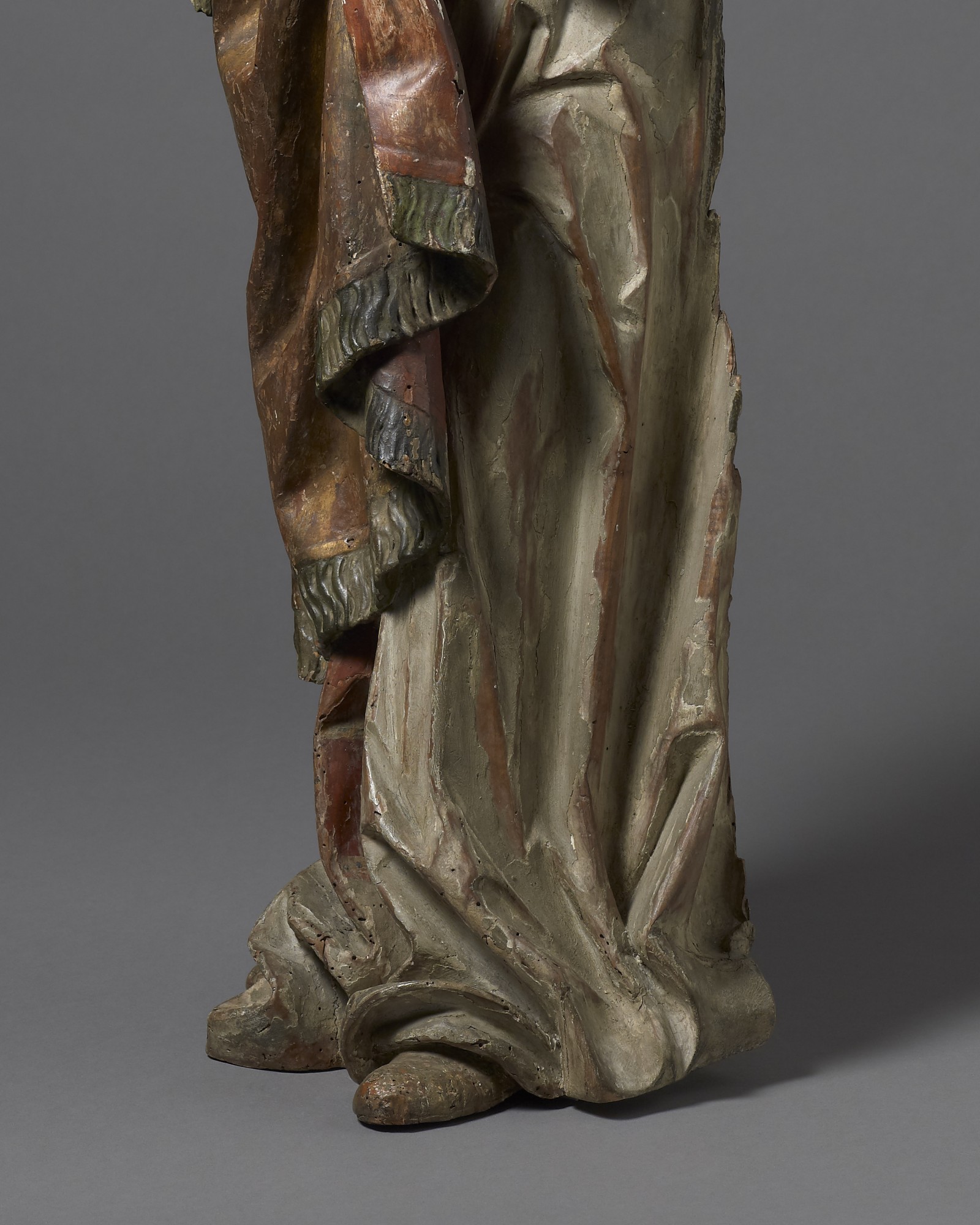


With Madame Jacqueline Boccador, Paris
N. Rasmo, Michael Pacher (C.H. Beck, München, 1969), figs. 6, 8, 54
A. Schwabik, Michael Pachers Grieser Altar (F. Bruckmann, München, 1933), pp. 54-58, 81
O. Schürer, Michael Pacher (Velhagen & Klasing, Bielefeld / Leipzig, 1940), pp. 18-20
T. Müller and A Feulner, Geschichte der Deutschen Plastik (F. Bruckmann, München, 1953), pp. 341-346
T. Müller, Sculpture in the Netherlands, Germany, France and Spain: 1400 – 1500 (Penguin Books, Middlesex, 1966), pp. 120-123
Michael Pacher was a Tyrolean sculptor and painter active during the last third of the 15th century. He was amongst the first to introduce the principles of Renaissance painting into Germanic art. Born in 1435 near Brixen on the southern slopes of the Alps in Tyrol, little is known of Pacher’s training. He visited Padua in northern Italy, where he became heavily influenced by the modern fresco work of Andrea Mantegna and Jacopo Bellini. Mantegna was considered the renowned master of perspective, whose striking, low-set standpoint spatial compositions were important to the development of Pacher’s own style. Unlike most German and Austrian artists of the late 15th century, Pacher’s inclination towards the Italian influence set him apart from his counterparts. His fusion of Italian Renaissance and northern Gothic realism shaped the development of his uniquely personal approach.
Pacher is recorded in 1467 as a distinguished artist in Bruneck, some twenty-five miles east of Brixen in the Puster Valley, where he had a workshop making altarpieces. His remarkable skill as a wood carver and painter saw him in demand for German style altars. Pacher spent much of his time during the 1470s in Neustift working primarily on painting frescoes. Many of his works were destroyed or badly damaged during hostilities in the late 17th century and then in 1709. His most important surviving works include the altarpiece of St. Wolfgang in the Salzkammergut (1471 – 1481), the altarpiece in the parish church of Gries near Bozen (Bolzano) (1471 – 1475) and the altarpiece of the Church Fathers created in 1483 for Neustift Monastery. The first of these works, a polyptych or Wandelaltar, commissioned for Abbot Benedict Eck of Mondsee, is considered one of the most remarkable carved and painted altarpieces in all of European art.
This beautiful representation of Saint Lawrence made in the workshop of Pacher is carved in stone pine, a soft alpine wood which was favoured in the Tyrol. The slightly turned form to the right shoulder, hollowed back and lowered eyes suggest its original integration in a shrine placed to the right (as seen by the viewer) of the main character of the altarpiece.
The work is exceptional for the quality of the carving and state of the original polychrome. Of particular refinement and elegance is the exquisite perfectly preserved face of the martyr framed by intricate delicately carved locks of hair. His downward gaze with slightly heavy eyelids conveys a pensive restful almost serene mood which belies the gruesome nature of his martyrdom during the persecution by Emperor Valerian in 258.
The young Saint Lawrence holds in his left hand proper a closed gospel book and, in his right, the stem of the lost gridiron, the two attributes with which he is most often depicted. One of the seven deacons of ancient Rome with special responsibility for the poor, Saint Lawrence was roasted to death on a gridiron exclaiming to his persecutors according to legend: ‘thou has roasted that one side; turn that other and eat’. He is the patron saint of chefs and cooks and, due to his attributed levity at a time of agony, comedians.
The martyr wears the garments of his rank as a deacon proper: a tunic, humeral veil and alb. The material falls in long vertical trains and square shaped folds, the drapes gathering to cover his shoes. Although such elements are evident in works from the early 1460s (cf: the drapery found on the Muttergottes from the altar of Saint Lawrence in St. Lorenzen in Bruneck completed c. 1462 – 1465), the facial structure and the modelling of the curls of hair date the work to between 1470 – 1475. The clear almond-shaped contoured form of the eyes, the eyelids, arched brows, slender nose, thin lips, chin and wrinkles are elements typical of male figures carved by Pacher in the early 1470s (cf: the reliefs of the high altar of Gries completed between 1471 – 1475).
The excellence of the craftsmanship confirms execution by the most highly skilled of assistants in the workshop of the master. The extraordinary quality and subtlety of the face evidences direct involvement by his hand, a common practice in late medieval workshops.
We are grateful to Dr. Frank Matthias Kammel, Head of Collections and Sculpture to 1800 and Programme Director of Special Exhibitions, Germanischen Nationalmuseum, Nuremberg, for confirming the attribution to Michael Pacher and workshop based on first hand examination of the work.
SOLD: Private colection, Belgium